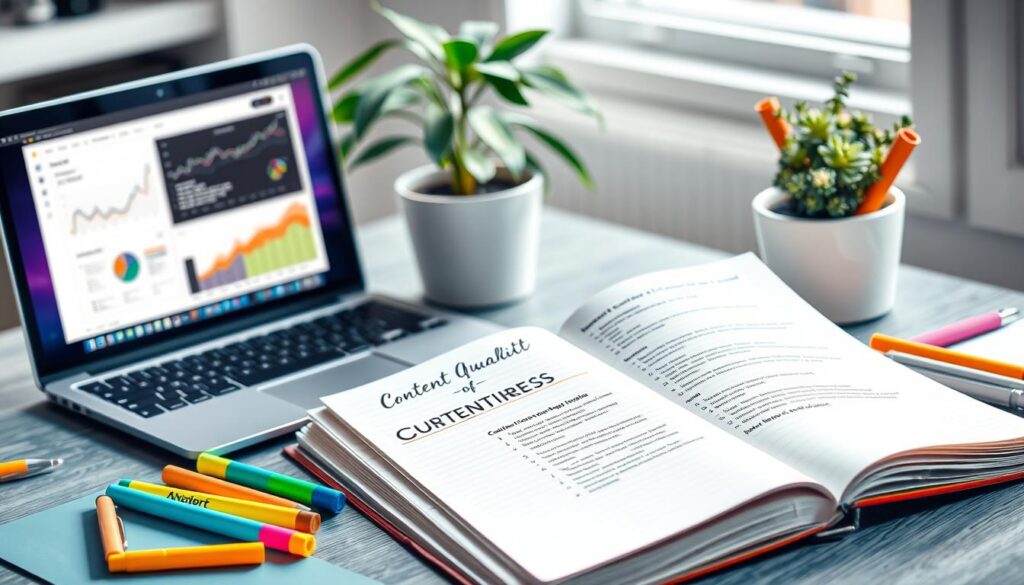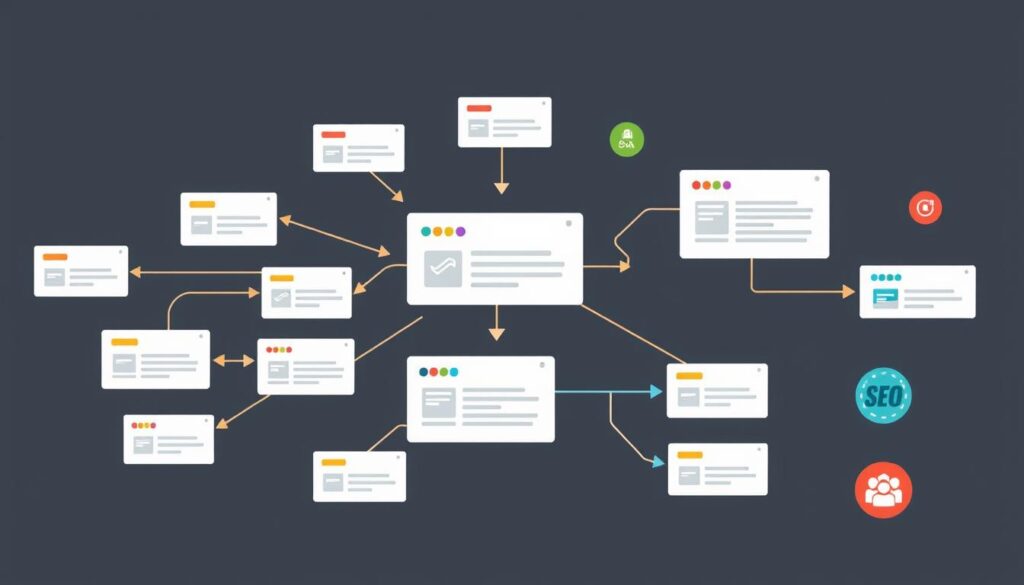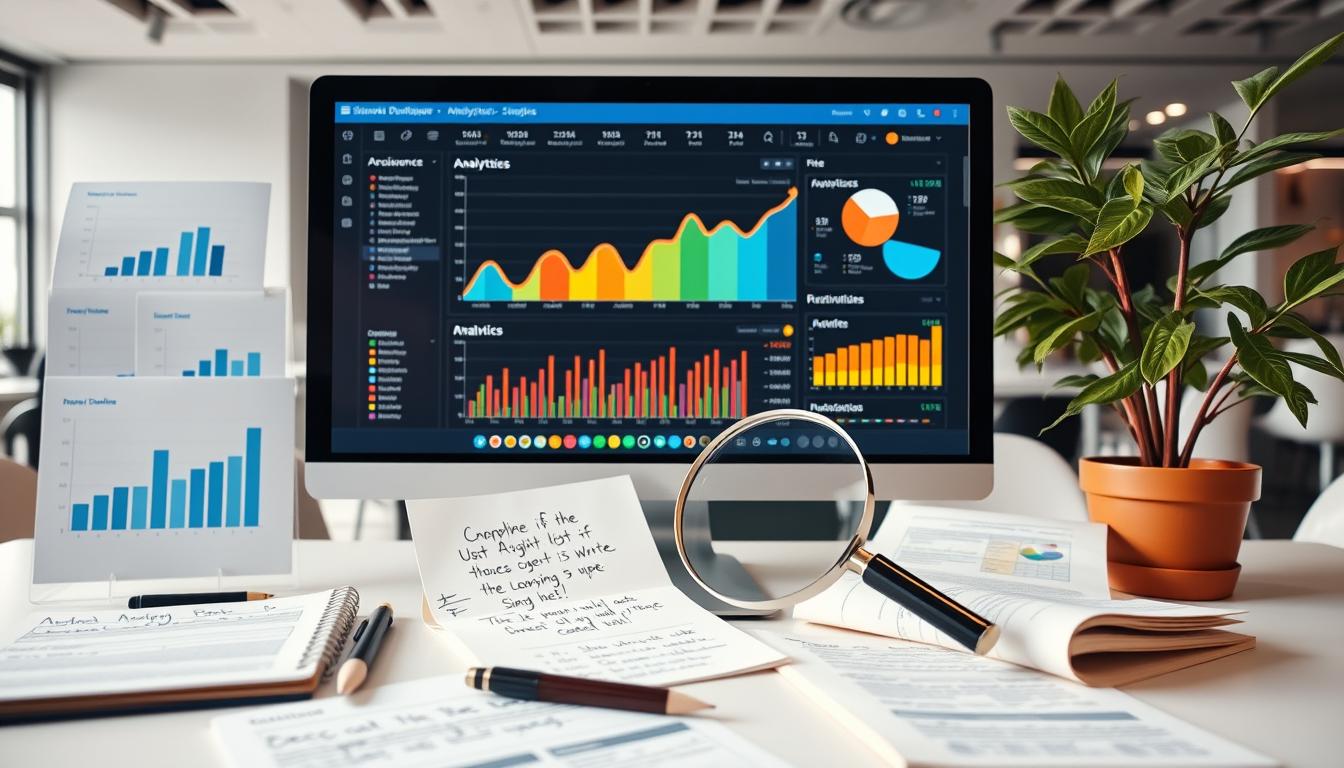Approximately 93% of online interactions commence with a search engine query, underscoring the indispensable role of a website’s optimization in attracting potential visitors. On-page optimization is instrumental in refining your SEO friendly website design, directly influencing search engine interpretation and ranking of your content. By adopting effective on-page optimization strategies, including meticulous meta tags optimization and the creation of high-quality content, businesses can substantially enhance their visibility and user experience enhancement.
Key Takeaways
- On-page optimization is crucial for improving search engine rankings.
- Meta tags optimization directly impacts how search engines assess your site.
- Implementing user experience enhancement strategies is essential for retaining visitors.
- Quality content creation fosters trust and engagement among your audience.
- Utilizing effective SEO friendly website design can attract more organic traffic.
Understanding On-Page SEO Basics
On-page SEO is a discipline that optimizes individual web pages to elevate their search engine rankings and draw in more pertinent traffic. This endeavor transcends mere technicalities, profoundly enhancing the user’s experience. Mastery of on-page SEO fundamentals empowers webmasters and marketers to craft content that resonates with both search engines and users.
What is On-Page SEO?
On-page SEO encompasses the strategies and methodologies applied directly to a website’s pages. It involves optimizing elements such as content, title tags, meta descriptions, and URLs. When executed effectively, on-page SEO enables search engines to decipher the content, thereby enhancing a website’s visibility in search results.
Importance of On-Page SEO for Websites
In the contemporary digital realm, the significance of on-page SEO is paramount. It is instrumental in shaping a site’s performance in search engine rankings. By refining on-page elements, businesses can ensure their content’s accessibility and relevance. Moreover, adhering to SEO friendly website design principles, such as intuitive navigation and well-structured content, amplifies engagement and user retention. A website optimized for search engines not only attracts traffic but also converts visitors into loyal customers.
Keyword Research Essentials
The cornerstone of successful on-page SEO lies in the realm of keyword research. By employing a variety of strategies, one can significantly increase the likelihood of attracting targeted traffic. The utilization of specialized tools streamlines this endeavor.
Tools for Effective Keyword Research
Platforms such as Google Keyword Planner, Ahrefs, and SEMrush are instrumental in uncovering keywords that enhance content visibility. These tools provide critical data on search volume, competition intensity, and emerging trends. They are essential for crafting a robust strategy.
Analyzing Competitor Keywords
Competitor keyword analysis offers a strategic advantage. It reveals the keywords driving traffic to competitors, thereby identifying content gaps that can be leveraged. This understanding allows for the refinement of your content strategy, positioning you competitively.
Long-Tail Keywords Explained
Emphasizing long-tail keywords can significantly boost content effectiveness. These longer, less competitive phrases are often associated with higher conversion rates due to their specificity. Incorporating long-tail keywords into your strategy enables a more targeted approach, enhancing engagement and conversion rates.
Crafting Compelling Title Tags
The creation of effective title tags is paramount in the realm of on-page SEO. These tags serve as a conduit of critical information to both search engines and users, thereby influencing click-through rates. The implementation of appropriate strategies is imperative to elevate visibility and engagement.
Best Practices for Title Length
Adherence to optimal title length best practices is crucial for optimal display in search results. Titles should ideally span between 50-60 characters. This range minimizes the risk of truncation, ensuring that users can view the entire title without missing out on key elements.
Incorporating Your Primary Keyword
Incorporating primary keywords at the outset of your title tag enhances its relevance. This strategic placement aids search engines in comprehending your page’s content, thereby increasing the likelihood of a higher ranking. Prioritizing keyword placement is a proven technique for optimizing title tags.
Making Titles Catchy and Relevant
Crafting titles that are both catchy and relevant can significantly impact user engagement. Utilize actionable language that captures attention, encouraging readers to click. Clearly communicating the content’s offerings helps establish user expectations and fosters trust.
Writing Engaging Meta Descriptions
Meta descriptions, serving as concise summaries, appear beneath the title in search engine results. They are pivotal in capturing user interest and influencing click-through rates. Effective meta tags optimization strategies are essential for boosting online visibility. Crafting compelling descriptions necessitates an understanding of their significance and adherence to specific guidelines.
Why Meta Descriptions Matter
Engaging meta descriptions can captivate potential visitors. These descriptions not only assist search engines in comprehending your content but also inform users about the content they will encounter upon clicking your link. An optimally crafted meta description can significantly enhance engagement and drive higher traffic.
Character Limit Guidelines
Compliance with character limit guidelines is crucial for maximizing the efficacy of your meta descriptions. Descriptions should ideally span between 150 and 160 characters. Adherence to this range ensures that your entire message is visible on search engine results pages. This approach improves user experience and encourages click-throughs.
Tips for Writing Effective Descriptions
Several key strategies are involved in crafting effective descriptions:
- Employ active voice and action-oriented language to instill a sense of urgency.
- Integrate relevant keywords naturally to align with user queries.
- Ensure descriptions are concise yet informative for clarity.
Each of these elements is critical in ensuring your meta descriptions resonate with your target audience. A well-crafted meta description can substantially impact click-through rates, distinguishing your content in a crowded digital environment. For additional insights on crafting effective descriptions, refer to this guide.
Optimizing Header Tags
Header tags are indispensable for structuring content, catering to both search engines and readers. Through optimization, they enhance header tags optimization and establish a clear content hierarchy. The H1 tag signifies the primary title, while H2 and H3 tags segment content into manageable sections and subsections. Recognizing the significance of header hierarchy is crucial for presenting information in an organized manner.
The Role of H1, H2, H3 Tags
The H1 tag must be unique for each page, encapsulating the primary keyword that encapsulates the content’s focus. H2 tags act as major sections, further dividing the content and sustaining reader interest. H3 tags elaborate on H2 headings, enabling a more profound comprehension of the subject.
Best Practices for Header Hierarchy
Consistency in header hierarchy is paramount for enhancing user experience. Prioritizing H1 tags at the outset, followed by H2 and H3, underscores the importance of header hierarchy. Restricting H1 tags to a single instance per page maximizes their efficacy. Employing H2 and H3 tags in a logical sequence ensures that readers can effortlessly navigate through the text, avoiding any confusion.
Including Keywords in Header Tags
Integrating relevant keywords within headers significantly boosts SEO value. Incorporating keywords in H1, H2, and H3 tags underscores their importance within the content. This strategy not only assists search engines in comprehending your page but also captures reader attention. The effective inclusion of keywords in headers enhances the overall efficacy of the content.
Creating Quality Content

The creation of quality content is paramount in the realm of on-page optimization. It not only elevates your website’s authority but also fosters trust among your audience. By strictly adhering to content quality guidelines, you lay the groundwork for effective online communication.
Importance of Original Content
In the vast expanse of online information, original content emerges as a beacon of distinction. Search engines favor unique articles, ensuring that users gain valuable insights rather than redundant information. By cultivating a distinct voice, you not only ascend in rankings but also underscore the importance of original content for user engagement.
Content Length and Depth Considerations
Understanding the nuances of content length is a pivotal aspect of quality content creation. Studies reveal that longer, more detailed articles often surpass their shorter counterparts in search engine rankings. Such comprehensive content satisfies readers’ queries while enriching their overall experience on your site. Strive for depth and detail that resonates with your audience’s needs.
Engaging Your Audience with Multimedia
The incorporation of multimedia elements, such as images, videos, and infographics, can dramatically elevate user engagement. These elements serve more than a decorative purpose; they provide context and maintain visitor interest. A diverse array of content types offers a more immersive experience, catering to different learning preferences. Remember, adherence to content quality guidelines results in a more captivating presentation. For additional insights on quality content creation, refer to this guide on flawless on-page SEO.
Image Optimization Techniques
Adopting advanced image optimization techniques is paramount for elevating both user engagement and SEO efficacy. The significance of image optimization is profound; optimized images expedite loading, thereby boosting page performance and user interaction.
Why Image Optimization is Crucial
Images play a pivotal role in determining page load times, influencing visitor interactions. Slow-loading images can precipitate increased bounce rates. Optimizing images not only enhances visual appeal but also fortifies search engine rankings.
Suggested File Formats and Sizes
Optimal results necessitate the selection of suitable file formats and adherence to recommended sizes. Employ JPEG for photographs and PNG for graphics with transparent backgrounds. Aim for image sizes under 100 KB, contingent upon context, to ensure rapid loading.
Using Alt Text Effectively
Provision of descriptive alt text is crucial for accessibility and SEO. Alt text facilitates search engines’ comprehension of image content. Strive for brevity while incorporating relevant keywords. For a deeper dive into image optimization strategies, consult this resource.
Implementing these methodologies can markedly enhance content efficacy and visibility. Regularly assess and refine your images as part of comprehensive optimization endeavors to maintain digital competitiveness.
Enhancing Internal Linking Strategy

Internal linking is pivotal in search engine optimization, facilitating both user and search engine navigation through a website. By adopting robust internal linking strategies, website proprietors can capitalize on the advantages of internal links to bolster their site’s SEO efficacy. Mastery of internal linking best practices is essential for content structuring, thereby enhancing visibility and usability.
Benefits of Internal Links
The utilization of internal links offers manifold benefits, including:
- Enhanced site navigation, resulting in a superior user experience.
- Facilitated indexing by search engine crawlers, leading to more efficient page discovery.
- Augmented page authority distribution across the site.
- Potential decrease in bounce rates as users are directed to pertinent content.
Best Practices for Link Placement
To optimize the efficacy of internal links, adhere to these best practices:
- Integrate links organically within content to preserve readability.
- Employ descriptive and pertinent anchor text for clarity.
- Link to pages that are germane to the current topic.
- Avoid overloading a page with an excessive number of links; such an approach can diminish the value of each link.
Avoiding Common Internal Linking Mistakes
Avoid common internal linking pitfalls to ensure optimal outcomes:
- Employing vague anchor text, which can perplex readers and diminish SEO benefits.
- Linking to pages that are irrelevant to the current content, failing to add value.
- Ignoring the update of internal links when content is revised or relocated, resulting in broken links.
- Overlooking the inclusion of crucial pages in your linking structure, which can impede their visibility.
Ensuring Mobile-Friendliness
The proliferation of mobile internet access necessitates a profound understanding of mobile responsiveness. This is paramount for any website aiming to enhance user experience and influence search engine rankings. Mobile optimization transcends mere user satisfaction, significantly impacting search engine rankings.
Mobile Optimization Importance
Mobile optimization is about delivering an optimal viewing experience across a spectrum of devices. It encompasses effortless navigation, text legibility without the need for zoom, and rapid loading times. Neglecting mobile friendliness can result in elevated bounce rates, detrimental to both user engagement and SEO performance.
Responsive Design vs. Mobile Sites
The ongoing debate between responsive design and dedicated mobile sites is a contentious issue among web developers and SEO specialists. Responsive design dynamically adjusts to the device’s screen size, ensuring a seamless user experience across all devices. Conversely, dedicated mobile sites necessitate separate URLs and maintenance, complicating SEO efforts. Selecting the most appropriate approach hinges on understanding your target audience’s preferences.
Tools for Testing Mobile Friendliness
Ensuring a website’s mobile optimization standards are met requires the utilization of testing tools. Google’s Mobile-Friendly Test is a widely used resource, offering insights into mobile performance. These tools provide actionable recommendations to bolster mobile responsiveness, ensuring a positive user experience.
Monitoring and Improving Your On-Page SEO
The maintenance of an efficacious on-page SEO strategy necessitates an ongoing cycle of monitoring and enhancement. The deployment of advanced tools for the analysis of on-page, such as Google Analytics and Moz, furnishes invaluable insights into your website’s performance. These instruments deliver critical metrics, facilitating the identification of areas requiring attention. This ensures that your content remains in harmony with the evolving standards of search engines and the evolving preferences of users.
Tools for Analyzing On-Page SEO
The utilization of sophisticated SEO analysis tools empowers you to assess the efficacy of your on-page strategies. The monitoring of on-page SEO is paramount for comprehending the contributions of your website’s various elements to overall rankings. Performance reports enable the tracking of modifications and their repercussions, facilitating the making of informed decisions based on data.
Keeping Up with SEO Trends
The digital environment is perpetually in flux, rendering it imperative to remain abreast of SEO trends. Search engines, such as Google, frequently revise their algorithms, rendering previously effective strategies obsolete. The acquisition of knowledge regarding these trends allows for the timely adaptation of your strategies, thereby preserving or augmenting your site’s visibility.
Regularly Updating Content for Relevance
Another critical component of a successful on-page SEO strategy is the regular updating of content to maintain relevance. The creation of fresh, captivating content not only engages your audience but also signals to search engines that your site remains active. This continuous endeavor contributes to sustained visitor traffic and enhanced rankings, underscoring the importance of ongoing SEO investment.
